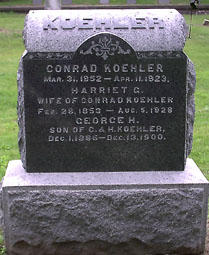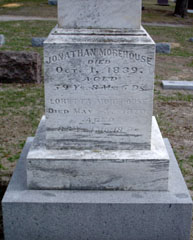On the River
Muscatine, Iowa
Rivermen
Part III
Book
compiled and copyrighted by
Georgeann McClure
~~~~~~~~
| |
 |
|
|
|
photo McClure
Mississippi Queen steamboat under the Muscatine, Iowa bridge.
|
|
Koehler, Conrad
|
 |
 |
|
Greenwood Cemetery,
Muscatine, Iowa |
Conrad Koehler |
MAYOR DROWNS
April 12, 1923
CONRAD KOEHLER MEETS TRAGIC END IN
MISSISSIPPI AS BARGE UPSETS NEAR MUSCATINE TODAY
~~~~~~~~~~~~~~~~~~~~~~~~~~~~~~~~~~~~~~~~~~
Believe Water in Hull and Sand Caused Tragedy
DEATH SHOCKS CITY
Body Not Recovered up to 2 O’clock
Accident Occurs at Koehler Gravel Pit in River
Conrad Koehler, 71 former mayor of Muscatine and one of the best
known river men along the upper Mississippi, was drowned about 10
o’clock this morning when a barge on which he was working turned
over in the Mississippi river at his gravel pit four miles below
Muscatine. The body had not been located up to 2 o’clock.
Eli Atkins, 1101 East Seventh street, with Koehler on the barge
escaped by jumping safely to the “E. L. K.” Koehler’s boat to which
the barge was tied. Two other members of the boat’s crew. B. R.
Litwelder, 307 Chestnut street and John Bear, 419 East Front street,
witnessed the tragedy from other boats.
Exactly what caused the barge to turn over is a matter of
conjecture. According to Litwelder there was considerable water in
the bottom of the barge, which is about 80 by 20 feet. It was about
two-thirds loaded with sand pumped from the pit., Litwelder says,
the load being on one side. A tilt of the barge, which sent the
water in the bottom to one side, is thought to have caused the craft
to turn over on its edge. The ropes holding it to the “E. L. K.”
were snapped off and the side of the barge glanced off the pilot
house of the steamer.
When the barge tilted Atkins succeeded in jumping to safety. He was
near the steamer. According to him, Koehler was on the far side of
the barge and although he made a gallant attempt to climb the
precipitous incline as the craft turned over on its side, he fell
back into the river. Life preservers and ropes were thrown to him as
he appeared above the surface some distance from the sinking barge.
He succeeded in grasping one rope, Litwelder says, only to let go
when he apparently made another attempt to reach the barge.
Rises but once
Koehler rose but once after he was thrown into the water, the men
who witnessed the tragedy say. The current at this point is swift
and the water extremely deep because of his pumping operations which
have been going on at Koehlers gravel pit, located about one-third
of the distance across the river out from the Iowa shore.
The barge, says the men, did not turn completely over but sank after
tilting at a steep angle and precipitating most of its cargo of sand
into the stream.
Drag for Body
The three men summoned aid after finding their efforts to reach
Koehler fruitless. Dragging was started soon after the tragedy. The
boat crew brought the E. L. K. back to Muscatine late in the morning
to secure additional help in searching for the body. It is believed
that the swift current may have carried the remains some distance
from the scene of the accident.
The Koehler gravel pit where operations were being carried on is
located at the head of what is known as “Freeman’s” crossing and on
a line out in the river from the pits of the Automatic Gravel
company.
Koehler carried on an extensive sand and gravel business renting
part of the levee at the foot of Mulberry avenue for unloading and
distributing purposes. Word of his tragic death spread quickly and
was a shock to the entire community.
Native Resident of City
Koehler was born March, 1852, in Muscatine, and resided here his
entire life. He married Miss Hattie Griffith, to which union three
children were born, two of whom preceded him in death.
Not only was Mr Koehler a prominent local sand and gravel dealer for
more than half a century, but he also was a leading figure in city
politics for years. He was elected mayor in 1912 on the democratic
ticket and served one term.
Besides his widow he is survived by a daughter, Mrs. George Daut of
this city; two sisters, Mrs. Gus Althaus and Mrs. Christ Vogel also
of Muscatine; three brothers/George and John Koehler of this city
and Ed Koehler of Aberdeen Wash.
~~~~~~~~~~~~~~~~~~~~~~~~~~~~~~~~~~~~
Middleton, John
Thomas Middleton
Capt. Middleton
Attend Musserville Island Church
Middleton, Benjamin
Middleton, Julia
Middleton, Lydia
Middleton,
Thomas
Middleton, William
Middleton, W. A
1866 Muscatine City Directory
John Middleton steamboat captain . res Island 1 3/4 mi w Court House
1876-1877 Caffee’s County Directory
Middleton T. L. fisherman res Musserville
Name: THOMAS MIDDLETON
Submitted by: Juanita Buckley Sapp
Date Submitted: Monday, February 05, 2001 12:26 PM
Source of Obituary: "MUSCATINE JOURNAL", Muscatine, Iowa, Monday,
June 24, 1929
Thomas Middleton, 76, died at this home 207 East Third Street, at
4:20 Sunday afternoon following an illness of almost six months with
heart disease. Mr. Middleton was born in Lancaster County, PA.,
February 6, 1853. He came to Muscatine when a child and had resided
here since that time. He married Lydia Purcell, November 1, 1876 and
she died about 22 years ago. He married Mrs. Hattie Fahey October
26, 1910. He was a member of the First Methodist Episcopal Church
and the AOUW Lodge. Survivors are his widow; two sons, Roy L. of
Atalissa and William T. of Sterling, Illinois; two sisters, Mrs. Emma
Mock and Mrs. Kate Comstock, both of San Francisco, California; one
half brother, Chris Middleton of Muscatine; eight grandchildren.
Funeral services will be conducted at the First Presbyterian Church
by the Rev. J. B. Rendall Tuesday afternoon at 2:30. Burial will be
in Greenwood Cemetery. The body was taken to the Wittich Funeral
Home and will remain there until services.----- Submitter's Note:
Thomas was the son of Benjamin Middleton and Mary M. Hoove.
~~~~~~~~~~~~~~~~~~~~~~~~~~~~~~~~~~~~
Morehouse,
Capts
• more on Morehouse brothers in Buffalo, Iowa rivermen
• on celtic cousins
|
Morehouse Stone
Greenwood Cemetery, Muscatine Iowa |
|
 |
|
 |
| |
|
|
|
Jonathan Morehouse
Died: Oct 1, 1839
Age: 59 yrs 8 mos 6 dys |
George
Died: August 23, 1835
Age: 10mos 23 dys |
D. B. Morehouse
Died: April 19, 1869
Age: 63 yrs 10mos 9 dys |
|
|
Sarah
Died: July 18, 1868
Age: 26 yrs 12 dys |
|
|
|
Edwin
Died:
April 20, 1843
Age:
6 yrs 4 mos 5 dys. |
|
|
|
Charles
Died: August 1, 1843
Age: 1 yrs 5 mos |
|
|
Loretta
Morehouse
Died: May 3, 1870
Age:
85 yrs 1 mos 18 dys |
Joseph
Died: January 18, 1844
Age:
5 yrs 10 mos |
Charlotte
Morehouse
Died: May 6, 1858
Age:
45 yrs 2 dys |
Captain D.B. and Captain Legrand Morehouse are well known on the
Mississippi River. Legrand was on
the main boat during the Grand excursion.
The Morehouse memorial stone can be found in Greenwood Cemetery in
Muscatine, Iowa. I was told the
stone was brought in from the Morehouse farm near Buffalo, Iowa.
(The Morehouse family are not at this site.
Their Biography can be found in History of Davenport and Scott
County Iowa by Harry Downer Vol.
Glendale Cemetery Leclaire Iowa transcribed by Paul Pruden
Moorehouse, Dickerson B., 1844-1913
Moorehouse, Mary Ellen, 1851-1901
Moorehouse, Stella C., 1881-1947
~~~~~~~~~~~~~~~~~~~~~~~~~~~~~~~~~~~~
James W. Neally
The Palimpsest
Sept 1964
BLOOMINGTON COMES OF AGE
Pg. 351-352
“On July 2, 1838, the county commissioners granted James W. Neally a
Bloomington ferry license good for one year.’ The rates prescribed
were each footman, 25 cents; man and horse, 50 cents; wagon and two
horses or yoke of oxen, $1.50; each additional horse, 25 cents;
cattle 25 cents; sheep and hogs 6 ¼ cents. These first ferries were
crude flat bottomed skiffs propelled by poles and oars.”
“On December 14, 1838, the territorial legislature granted Joseph
Williams and Charles Warfield the right to establish a horse or
steam ferry across the Mississippi at Muscatine. Their first ferry
was the flat boat Polly Keith built in 1839 by D. C. Cloud and
George Leffingwell. According to the Bloomington Herald the Polly
Keith was kept in “the Slough“, with ropes to propel it, so that
travelers coming to it can ferry themselves, their wagons and stock
across without difficulty.”
“This service was so inadequate that the Herald on December 11,
1840, carried an open letter regarding the “approaching forfeiture”
of the ferry privilege by Warfield and Williams who, it was
prophesied, could not obtain a renewal unless in “open defiance of
the unanimous will of our citizens.” since the ferry would soon
become a “valuable privilege” the writer believed Bloomington should
either be granted the charter or else a stock company of citizens
should be organized. In answer to this plea the Territorial
legislature passed an act on December 29, 1840, authorizing the
president and trustees to “establish and keep a ferry” across the
Mississippi for “one mile above and one mile below” Bloomington. The
town officials had “full and entire control” of the ferry and could
lease it for any period not exceeding ten years on terms “most
conductive to the welfare of the municipality.”
Bloomington Herald
Dec. 11, 1840
FERRY
Messrs. Editors-- As the period approaches which determines the
forfeiture of the ferry privileges granted to Warfield & Williams,
by first Legislature of Iowa, it behooves the citizens of our town
to take the subject into consideration, and devise such plans as
will be productive of the most good to the town and the citizens at
large.
That those gentlemen named will obtain an extension of the time
within which they were to have put the ferry afore said into
operation, cannot for a moment be supposed, without seriously
doubting the disposition and interest of our citizens as well as the
good sense of our legislators. In fact I do not believe they will
for a moment think of applying for what they know cannot and will
not be granted, unless in open defiance of the unanimous will of our
citizens and those of the adjacent country, on either side of the
Mississippi.
In this state of things what shall be done. It seems to me that one
of two courses should be taken: Either that the town, through its
corporate authority, should apply for the charter, or that it should
be invested in a stock company; care being taken that the shares be
of the proper size, and confined to the citizens of the town.
That the ferry privilege will in a few years become valuable, no one
will pretend to doubt. The interest and growth of the town
materially depends upon our securing the immediate interest to
ourselves, either corporately or collectively, and no longer suffer
the whole town and its interest to be absorbed or kept in check by
those4 who either have not the means or disposition to advance them.
H. J. P. T.
Muscatine Journal
August 18, 1889
Ten of the prominent young men of the city have guaranteed
sufficient funds to secure the elegant steamer Josephine and its
magnificent barge for Thursday evening, and a select dancing party
and excursion of the elite of the city will our thereon. The
Josephine and barge are the finest excursion outfit afloat on the
Upper Mississippi, and the event will be of the most elegant
character throughout. Invitations have been issued signed by the
committee of arrangements. Messrs Williams, McColm and T. H.
Fitzgerald, and the price of tickets placed at $1.50 ticket to
include dancing. It required considerable expense to secure so fine
a boat and barge, and there will need to be a large attendance to
keep “the ten” from coming up short.